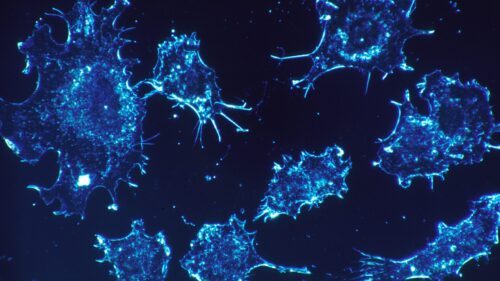Image courtesy of University of Illinois Urbana Champaign.
In the complex world of tissues, stem cells serve as the custodians of the epithelial layer, the thin covering of cells that sits atop the surfaces of organs and other structures in the human body. The stem cells actively identify and eliminate cells that pose a threat to tissue integrity. However, oncogenic mutations—genetic alterations that drive cancer development—can disrupt this delicate balance. Surprisingly, even in normal-looking tissues, these unfortunate mutations can be present with frequencies similar to those found in cancerous tissues. In order to understand how tissues stay healthy despite the many mutations, and to explore possible advances in cancer treatment, researchers have long sought to describe the biological processes that help cells dodge the mutation bullet.
Researchers from the Howard Hughes Medical Institute and Yale, led by Valentina Greco and Rachel Perry, investigated how metabolic states might influence the outcomes of cell competition in the skin. Their aim was to uncover the mechanisms that determine whether a mutated cell survives, integrates into the surrounding tissue, or is eliminated. “The body has mechanisms to deal with mutations, and our goal is to understand how these mechanisms work to maintain tissue integrity and eliminate potentially harmful cells,” Perry explained. The study focused on two well-known mutations—β-catenin gain-of-function (βcatGOF) and HrasG12V—that exhibit opposing behaviors in skin cells, making them ideal for studying how mutant cells interact with normal cells.
Previous studies on mouse skin with a mixture of mutant and normal cells have demonstrated that mutant cells employ various mechanisms to correct tissue abnormalities and restore normal function. The βcatGOF mutation, which activates a signaling pathway crucial for cell growth, leads to the selective differentiation and elimination of mutant cells, positioning them as “losers” in the competition for space within the tissue. In contrast, the HrasG12V mutation, which involves a constantly active version of the Hras gene (a key regulator of cell growth and survival), enables mutant cells to outcompete and integrate into the surrounding tissue, “winning” the battle. These opposing outcomes make skin an ideal model for studying cell competition, as its accessibility and visibility allow researchers to investigate how mutant cells outcompete or are eliminated by healthy cells.
The team tracked the fluorescence of certain molecules that reflect cellular redox states (the balance between chemically oxidized and reduced molecules) in normal and mutant skin stem cells in live mice. Cellular redox states are often used to indicate the metabolic status of cells. This technique, combined with techniques that track metabolic pathways, enabled researchers to observe how oncogenic mutations altered metabolic activity, influencing mutant cells’ energy production, survival, and competitiveness.
The study revealed that both βcatGOF and HrasG12V mutations caused a significant drop in the cellular redox ratio, indicating a shift toward more oxidized redox states—a hallmark of oncogenic transformation. However, the responses differed between the mutations: while redox imbalance persisted in βcatGOF mutants, correlating with their eventual elimination, HrasG12V cells quickly restored their redox balance, allowing them to thrive and integrate into the tissue.
To explore the therapeutic potential of targeting these metabolic changes, the team treated the mice with metformin, a drug often used to treat high blood sugar levels that can adjust cellular redox states. Remarkably, metformin reversed the usual cell competition outcomes in both mutant models. In βcatGOF mutants, the treatment prevented their elimination, allowing them to persist in the tissue. In HrasG12V mutants, it decreased their speed in reproducing, inhibiting tissue changes and preventing their competitive success.
These findings highlight the critical role of metabolic adaptation in determining the fate of cancer-causing cells in epithelial tissues. The ability of HrasG12V mutants to rapidly restore redox balance allows them to overcome selective pressures imposed by normal cells, enabling them to persist and expand. In contrast, βcatGOF mutants, unable to adjust their redox status similarly, are ultimately eliminated. As it turns out, some cancer cells proliferate by quickly balancing their internal chemistry, while others that cannot do this are destroyed by the body.
Looking ahead, Perry emphasizes the potential for early cancer intervention through metabolic pathway manipulation. “If we know that someone is at risk for cancer because of a genetic mutation, could we manipulate these metabolic pathways or the redox status of cells to lower their risk?” Perry asked. While current strategies for intervening in metabolism to prevent cancer are limited, Perry highlights the importance of understanding the molecular connections between cancer-driving mutations and potential interventions. Perry said, “In the future, we would love to explore whether we can manipulate these pathways metabolically to intervene.”

